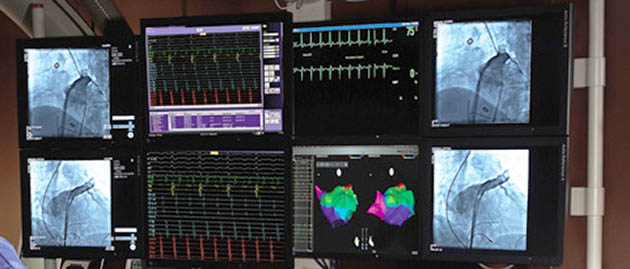A No-Radiation Catheter Ablation Option
Cardiac catheter ablation, a very effective treatment for common arrhythmias, especially atrial fibrillation or Afib, has traditionally been guided by a radiological medical imaging process known as fluoroscopy. However, advances in the field are making fluoroscopy, a radiation-based mapping system, obsolete.
Why Avoid Fluoroscopy
The benefits of avoiding radiation are very clear. While a typical one-off x-ray such as those used to diagnose lung infections or bone fractures emit a single, very low dose of radiation, fluoroscopy involves a continuous stream of x-rays to guide the catheter and map the heart. X-rays are cumulative in one’s lifetime. During a typical catheter ablation, patients are exposed to often unnecessary radiation. At teaching hospitals, where doctors are learning on patients, this can be exponentially increased. This cannot be fully mitigated by blocking x-rays with metal (lead), since we require unobstructed views and access to a large area of the torso. Avoidance of fluoroscopy is especially important for those who are more sensitive to radiation such as children, young adults and pregnant women.
The benefits of a no-radiation option also extend to doctors and staff, who do not have to wear protective lead suits and consequently are able to minimize fatigue throughout the day. Eliminating fluoroscopy allows the EP to concentrate without fatigue during long surgeries that otherwise would not have been possible.
Last, but certainly not least, nonfluoroscopic mapping is technologically superior and typically reduces the overall procedure time; if fluoroscopy is needed, its use can often be minimized. Shorter procedures equal better efficacy and lower risk of infection and other potential complications.
How We Do It
With extensive, advanced training and the latest imaging and mapping technology, some EPs have largely replaced fluoroscopy with the use of ultrasound guidance and 3D mapping. This technique was hard earned and is now recognized as one that sets the bar for excellence. This technique may actually produce better imaging and more precision throughout the procedure.

The Carto technology used in these procedures has advanced to such a degree that CT (computed tomography) imaging is usually no longer needed prior to the procedure. CT scans result in significant radiation exposure in their own right, so reducing X-ray during the procedure by getting a pre-procedure CT, results in no true radiation reduction benefit. Radiation dose is cumulative throughout ones lifetime.
Catheter ablation using no fluoroscopy, or using fluoroscopy in only a supporting role, is the future of minimally invasive arrhythmia treatment.

